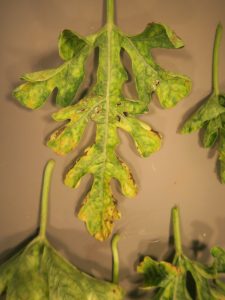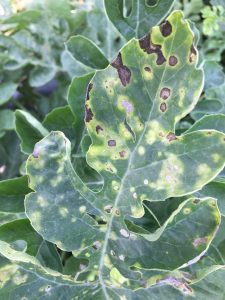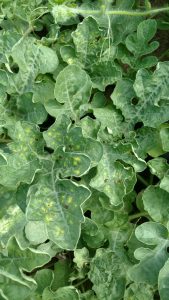I probably spend too much time posting photos of diseased vegetables on-line and presenting vegetable disease symptoms in presentations. My excuse is that recognizing the symptoms of what might be a disease seems important to me. However, it might be just as important to recognize symptoms that are not of an infectious disease. See below for some photos of leaves that do not have an infectious disease.

Figure 1: The first thing one will notice about the leaf shown here is the yellowing. The yellowing, also known as chlorosis, is not in spots or lesions. Instead, the chlorosis is generally throughout the leaf. Yellowing in specific lesions would be more likely to be disease.
Along the edge or margin of the leaf shown here can be seen some brown or necrotic tissue. For the most part, necrotic tissue along the edge of a leaf is due to some factor other than disease. Necrotic tissue in lesions, especially lesions that are surrounded by chlorosis, is more likely to be a disease.
The leaf in Figure 1 is a relatively old leaf. Older leaves tend to turn yellow with age. One reason for this is that nitrogen is mobile in the plant. When newer leaves are formed and need nitrogen, it can be pulled from the older leaf. This means the older leaf looks yellow and perhaps brown around the edges.

Figure 2: The chlorosis of the leaf in this figure is not general. It occurs in spots, almost lesion-like. However the yellow spots are never associated with necrosis. The sizes of the yellow spots varies too much to look like a disease. The yellow spots also vary widely in how much yellow occurs. The necrosis may occur deep into the leaf, but it almost always starts at the edge, a hint that the problem is not infectious. Finally, I do not recognize the symptoms as any of the ‘usual suspects’ of cucurbit diseases.

Figure 3: The chlorosis on this leaf at first seems to be in discreet lesions. However, at second glance, the lesions are in-between veins. Chlorosis between veins often is from non-infectious problems. The necrosis of these leaves also appears to occur between veins.
It is possible that non infectious problems can be important problems. However, none of the leaves here have symptoms of a problem I would say are yield limiting or lead to fruit quality problems. In addition, many growers want to know if the problem is infectious since the worry is that the problem will spread quickly across a field.
As I find more photos of leaves with non infectious problems, I will try to post them.
